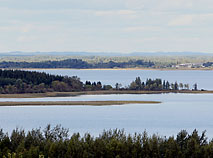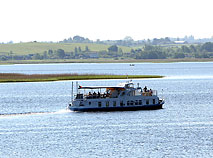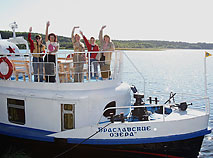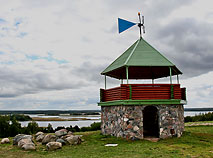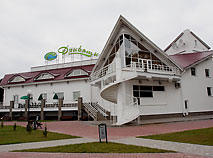Braslav Lakes National Park
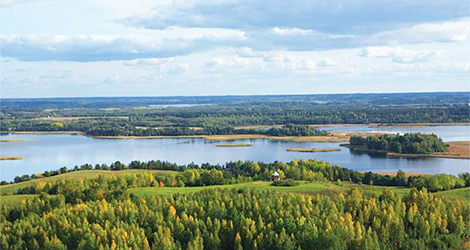
Hundreds of picturesque lakes, primeval nature and an unusual landscape shaped by the Ice Age made the Braslav region one of Belarus’ most amazing places.
Braslav Lakes National Park was established on the territory of the Belarusian Lake Area in 1995.
The administration of the park is headquartered in the ancient town of Braslav that rises on a hilly neck of land between the lakes of Drivyaty and Novyaty.
Braslav Lake Area
The Braslav Lake Area is famous for unusual landscapes and terrain left by the ancient glacier.
The major asset and pride of the region are its lakes. Here you can find about 300 lakes of various sizes, forms, depth, composition, water transparency, flora and fauna. For their unusual beauty they are called “the blue necklace” of Belarus.
The deepest lakes include South Voloso (40.4 meters deep), North Voloso (29.2 meters), Uklya (25 meters) and Strusto (23 meters).
The biggest ones are Drivyaty (36 square kilometers, the 5th largest in Belarus) and Snudy (22 square kilometers, the 8th largest in Belarus).
Here you can find relict invertebrates that live only in clean water as well as over 30 species of fish. The Braslav Lakes are home to about 35% of all birds nesting in Belarus.
Thanks to the ancient glacier, most of the Braslav Lakes have a very sophisticated form, with bluffy banks, numerous peninsulas, bays and gulfs.
Braslav District is a land of islands. There are over 100 of them, including some very unusual ones. For example, the island of Chaichin on the lake of Strusto (Belarus’ second biggest island of 1.6 square kilometers) has its own internal lake.
Defense installations were built on the islands amidst Ikazn and Drisvyaty lakes in the Middle Ages. A monastery stood on the island of Nespish in the 17th-19th centuries.
Fishermen and their families lived on the big islands until the 1940s, but now only tourists can be seen here.
Another peculiar feature of the Braslav landscape are its hills, including rounded setbacks and winding ridges of post-glacial osar.
The glacier left a lot of stones, including huge bowlders. The biggest bowlder in Braslav District weighs over 40 tonnes and can be found on the western bank of Strusto Lake.
Many of the ancient rocks were named by local residents. Those are God’s Footprint, Devil’s Footprint and Cow’s Stone.
History of Braslav Lakes National Park
Recreation opportunities of Braslav District were discovered back in the 19th century. Local aristocrats had their summer houses there, like the Plater family who owned the Belmont mansion.
In the 1920s Braslav was frequented by office workers and students from Vilnius and Warsaw, water lovers and summer visitors.
In the 1930s there were summer recreation facilities, children’s camps, three yacht-clubs, and sports grounds. Braslav became the venue of sailing competitions, festivals and exhibitions.
During the Second World War, the tourist infrastructure of the district was destroyed and laid in ruins up until the end of the 1950s.
The Braslav Lakes recreation center opened in 1958. A recreation resort Braslav was set up in 1970 and Braslav Lakes National Park was established in 1995.
Braslav Lakes today
Braslav Lakes National Park occupies about 70,000 hectares; it spans 55km from north to south and from 9 to 29km from west to east.
The national park features 74 lakes with a total area of 12,590 hectares (or 17% of its territory).
Its ecosystem consists of over 1,900 species of plants. Forests occupy about 67% of the territory and encompass several forestlands, like
-
Boginsky forest
-
Widzy forest estate
-
Belmont forest
-
Druya forest estate
-
Boruny forest
Thanks to a broad variety of ecosystems (forests, lakes, meadows, bogs), the animal world is extremely diverse, with 312 species of vertebrate animals living there, including:
-
216 species of birds (mute swan, black stork, common crane, herring gull, willow grouse)
-
45 species of mammals (elk, deer, roe deer, boar, as well as animals included into the Red Book of endangered species, like badger, lynx, brown bear, pond bat, northern bat)
-
34 species of fish (pike, perch, tench, bream, European carp, ide, catfish and eel, as well as species included into the Red Book, like vendace and smelt)
-
12 species of amphibians
-
5 species of reptiles.
Visitors to the national park can see wild animals in open-air cages. These animals are the most common fauna representatives of the Belarusian Lake Area.
Hikers and backpackers are invited to have a walk along eco-paths:
-
Belmont Park (an architectural and landscaping monument of the 18th-19th centuries, Belarus’ second biggest park after the park in Nesvizh)
-
Slobodkovsky Esker Ridge (breathtaking landscapes and rare forms of the glacier terrain featuring a mound dating back to the 7th century B.C.- 6th century A.D. and 11th-13th centuries A.D., a firing range of Polish border troops of 1920-1939)
Tourists from Belarus and abroad can choose from four recreation facilities located on the territory of the national park:
-
Drivyaty
-
Zolovo
-
Leoshki
-
Slobodka
The national park offers tours for fishermen and hunters with an opportunity to get unique trophies. International fishing tournaments are held here: Pike’s Luck and Braslav Spinning.
In a warm season tourists are invited to take a cruise ship tour on Drivyaty Lake.
How to get here and where to stay
Braslav Lakes National Park is located in Braslav District, Vitebsk Oblast. The national park is about 250km away from Minsk and 235km away from Vitebsk.
You can get here by car, by bus or by train (to the Druya station) from Minsk, Vitebsk and Polotsk.
Accommodation options of the national park include four recreation centers (comfortable vacation houses, holiday homes or cottages). If you choose to stay in Braslav, you can book a room in one of two hotels, the Braslav Lakes recreation center and the Braslav Lakes holiday camp. There are many rural tourism estates along the lake.
There are 30 equipped campsites with belvederes, fire pits, litter bags, toilets and paths to water.
Places to see in Braslav and its suburbs
If you come to the national park, you will certainly visit Braslav. The town has preserved the historical layout, while its downtown features buildings constructed in the 19th-20th centuries. The most famous landmarks of the town include:
-
Castle rock (9th-15th centuries);
-
Nativity of the Blessed Virgin Mary Catholic Church (1897);
-
Assumption of the Blessed Virgin Mary Church (1897);
-
Building of the St. Panteleimon Convent (early 20th century);
-
Mayak Mountain, the best observation place in the area of Braslav Lakes (174 meters).
The cultural and historical landmarks near Braslav include:
-
unique island citadels in the villages of Ikazn and Drisvyaty
-
Klyashtor Island (Monastery Island) on Nespish Lake
-
Maskovichi Hillfort
-
burial mounds in the villages of Uklya and Opsa.
If you travel to the town of Druya, 35km from Braslav, you will see Boris Stones, unique medieval artifacts dating back to the 12th century.
One of Belarus’ tallest neo-Gothic churches – St. Trinity Catholic Church (59 meters) – is located in the town of Vidzy.
A rural estate and a park with exotic plants can be found in the village of Vidzy-Lovchinskiye. The Lazenki recreation facility operated there in the late 19th century.
The Saint Anna Catholic Church (1792), a dendrological park and Europe’s first monument to Pope John Paul II can be found in the village of Mosar, Glubokoye District, not far from Braslav Lakes National Park.
The ancient town of Polotsk is just 130km away from Braslav.


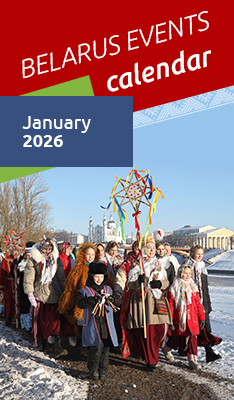




 print version
print version make home page
make home page add to bookmarks
add to bookmarks